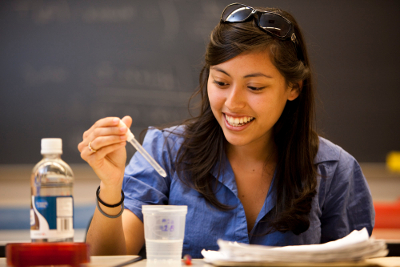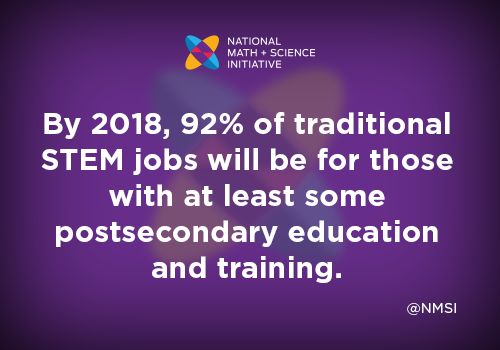Supporting Our Girls The Key to Closing the Gender Gap in STEM Education
Timothy Huneycutt |
March 25, 2014
 The American economy relies on the productivity, entrepreneurship, and creativity of all its people, yet women are being left behind in the critical fields of science, technology, engineering, and math. Supporting more women in STEM is the key, and NMSI is taking the steps to bridge this gap, but there is still much work to be done. To address and shed some new light on this pressing matter, STEMconnector and Tata Consultancy Services have issued a new white paper highlighting the vast disparities between men and women in the STEM world right now, as well as the opportunities that businesses, governments, and communities must seize in order to truly close the gender and achievement gaps and support more girls and women in STEM through education and mentorship.
The American economy relies on the productivity, entrepreneurship, and creativity of all its people, yet women are being left behind in the critical fields of science, technology, engineering, and math. Supporting more women in STEM is the key, and NMSI is taking the steps to bridge this gap, but there is still much work to be done. To address and shed some new light on this pressing matter, STEMconnector and Tata Consultancy Services have issued a new white paper highlighting the vast disparities between men and women in the STEM world right now, as well as the opportunities that businesses, governments, and communities must seize in order to truly close the gender and achievement gaps and support more girls and women in STEM through education and mentorship.
 In Women in STEM: Realizing the Potential, Balaji Gunapathy and his eight white paper co-authors assert that within the fields of science, technology, engineering, and mathrests “the key to the United States holding its position as the innovation and technology leader of the world,” as well as “the key to U.S. employment and prosperity.” This is because 80% of the fastest growing American jobs require a mastery and knowledge of math and science skills, and more than 1.2 million STEM positions are expected to be needed by 2018.
In Women in STEM: Realizing the Potential, Balaji Gunapathy and his eight white paper co-authors assert that within the fields of science, technology, engineering, and mathrests “the key to the United States holding its position as the innovation and technology leader of the world,” as well as “the key to U.S. employment and prosperity.” This is because 80% of the fastest growing American jobs require a mastery and knowledge of math and science skills, and more than 1.2 million STEM positions are expected to be needed by 2018.
However, as it stands right now, the U.S. won’t be able to fill a large portion of these STEM jobs – 230,000, to be exact – because we aren’t supporting a large portion of our workforce. Over 75% of STEM workers are men, while their female counterparts constitute less than 25%, despite the fact that nearly half of the U.S. workforce is comprised of women. “The gap between those numbers tells a story of squandered human potential,” states the report, and it is a story that begins in the classroom.
According to co-authors Edie Fraser and Julie Kantor, “at a young age girls feel ‘pushed out’ of STEM classes when they are in the minority, or ‘pulled out’ by their peers.” As a result, women and other minority groups earn only 45% of undergraduate STEM degrees, yet they collectively represent roughly 70% of American college students – and the numbers become even more disheartening when they’re broken down further. The white paper reports that, out every 100 female bachelor students, only 12 earn a STEM degree, and only 3 persist in STEM fields 10 years after graduation. The number of computer science degrees awarded to women has also sharply declined, falling from 42% to 12% over the course of just 12 years, even though the field of computer science will constitute more than 70% of all STEM jobs by 2018.
The U.S. economy needs more girls and women pursuing STEM degrees and careers, not just because of this vast gender gap, but because, in the words of the report, “innovation is critically dependent on diverse human experiences, and a diverse, STEM-trained workforce can be a significant competitive asset… to the U.S. as a whole.” How then, can we reverse this potentially damaging trend? According to the report, “it all begins in school.”
Education is one of the top three focus areas the authors of the report highlight – along with inspiration and retention – that will help increase the number of women in STEM education and careers, and “mentorship plays a crucial role in all three.” As it stands right now, girls who are interested in STEM face a plethora of obstacles while in elementary and secondary school, ranging from weak STEM education programs, to underprepared or unqualified teachers, to popularized misconceptions about the aptitude of girls in the subjects of math in science – and all of this is compounded by the fact that the country as a whole is struggling to perform well in the subjects of math and science, with students ranking 30th and 23rd on the international spectrum, respectively.
Our nation is very much embroiled in a STEM crisis, and this crisis will only intensify if we do not support women and empower them to be successful in the critical fields of math and science. It truly does begin in school, which is why NMSI is committed to supporting and enriching the STEM education programs in each and every one of our schools – and the fruits of our labor have proven its merits. Schools that have implemented our College Readiness Program (formerly known as NMSI’s Comprehensive AP Program) have seen an average first year increase of 72% in the number of passing AP scores in math, science, and English – that’s ten times the national average. In fact, NMSI’s School of the Year even saw an average first year increase of 137% in passing AP scores. The numbers are even more encouraging for our female students, who see an average increase of 87% in the number of passing AP math and science scores in the first year of our program, compared to the national increase of 8.7%.
The white paper concludes with “a strong national call for mentors” for girls and women in STEM, and NMSI is answering this call by training more and more of America’s teachers so that they can serve as strong academic mentors for not only girls, but for all of our students. We are inspiring more students to pursue careers in STEM, and we’re helping teachers become better student mentors by giving them the support and resources they need to ensure student success. The only way our country is going to thrive in the knowledge economy of the future is if we start fostering, supporting, and nurturing student curiosity for STEM within our classrooms.